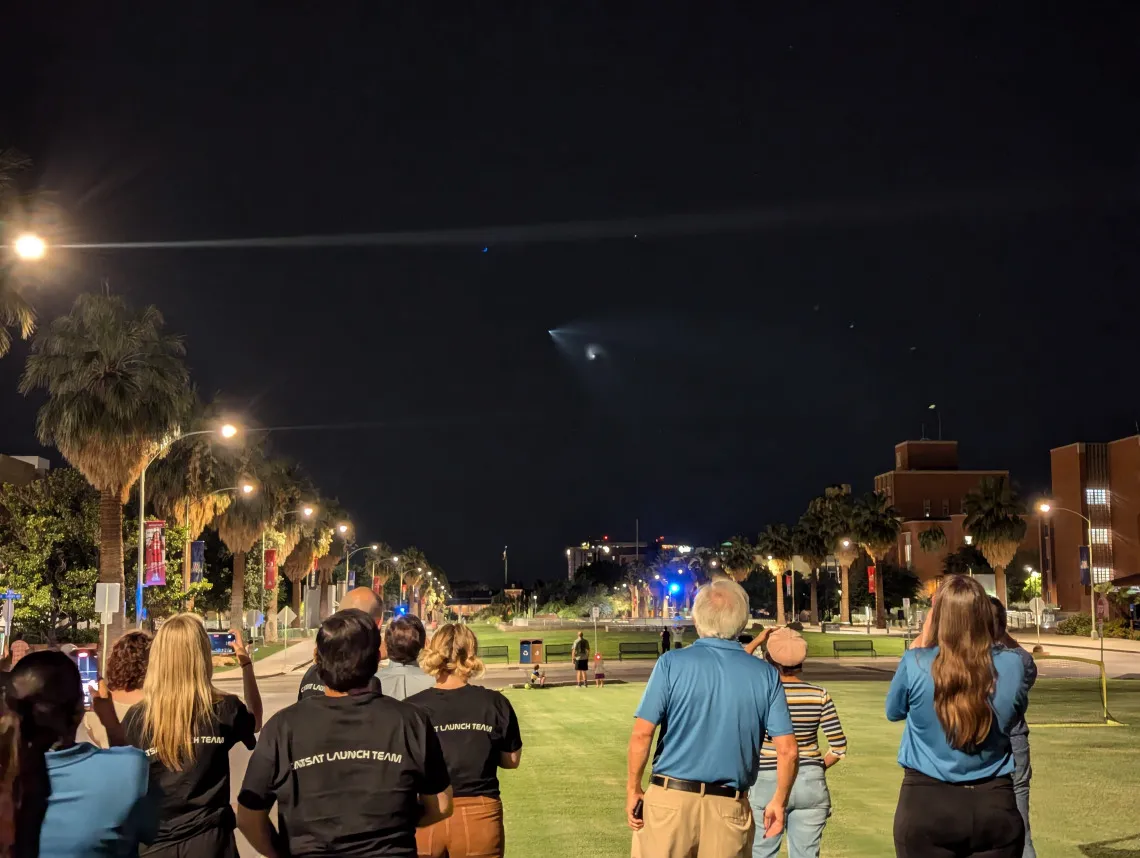Student-Led and Built CatSat Satellite Successfully Communicates After Launch Uncertainty

CatSat Team Observes the Launch in California, from the U of A Mall
CatSat Team
After a harrowing and multi-day delayed launch window the University of Arizona's first student-built satellite, CatSat, successfully communicated with ground stations on July 15th. The communications were met with excitement, alleviating fears that the spacecraft had been lost after its launch on July 3rd. The launch, conducted by Firefly Aerospace on the Noise of Summer with support from NASA and Space Force, initially left mission controllers and Arizona students and faculty uncertain about the satellite's status.
The launch finally occurred after three previous evening attempts from the Vandenberg Space Force Base in California. Walter Rahmer, Wyant College of Optical Sciences PhD student and integration and test engineer on the CatSat mission, recounted the tense period following the launch. “After launch, we were pretty sure we lost the spacecraft,” Rahmer said. “Our deployment was not confirmed, the Space Force only reported 8 of 9 objects resulting from our launch, and we weren't hearing anything at CatSat's frequency.”
The breakthrough came almost two weeks later, on July 15th, when a ground station in the Netherlands unexpectedly picked up CatSat’s signal. “To say we were ecstatic and in disbelief when the first signals were received would be an understatement,” Rahmer shared. “Many memes were thrown around. It really felt like a miracle had happened.”
Since re-establishing contact, the CatSat team has been busy communicating with the satellite and receiving telemetry data. However, they have not begun science operations or capturing any images yet.
The satellite's launch was a memorable event for the team. “The launch was incredible, we went out to the mall to see it and it was so beautiful. Everyone was excited, especially when the rocket didn't blow up,” Rahmer recalled. “Immediately after, emotions went from confused to somber when we thought CatSat might not have deployed. You can imagine our joy when two weeks later the spacecraft came alive!”
Looking ahead, the team is focused on continuing the commissioning of CatSat, a crucial step before starting any scientific operations. The first picture from the satellite is highly anticipated and will likely be celebrated with a team party. Following that, the science payload will be commissioned and used to gather data. “Only after we get a good batch of science recordings, at least a month or so out from here, will we deploy and begin testing the inflatable antenna,” Rahmer explained. The spacecraft is expected to remain in orbit for about two years before burning up in the atmosphere.
Rahmer has been involved with the CatSat project for over two years, contributing to various aspects from integration and testing to software development and ground station setup. The project is headed by Chris Walker, Professor of Astronomy and Optical Sciences, who was initially inspired to create the inflatable antenna based on observations of light reflections on a pot of pudding covered with plastic wrap. This led to the development of the Large Balloon Reflector, an inflatable technology that creates large collecting apertures, weighing a fraction of today’s deployable antennas.

CatSat Team
The CatSat mission is a significant milestone for the University of Arizona, showcasing the capabilities and creativity of student-led space missions. From the onset of the mission, it has been student-driven and built. Starting in 2018, students were hands-on with the satellite starting from the design to the building of the hardware—working in campus clean rooms on hardware, visiting ground stations and launch sites, and pursuing mission milestones such as vibrational testing and integration. The experience has enabled students from many different departments and colleges; including optical sciences, aerospace engineering, electrical engineering, systems engineering, and astronomy, to engage with work that may be the most inspiring and intense entries on their résumés.
Updates on the satellite’s progress can be found on their newly updated website, which includes links to an online satellite tracker and a public dashboard displaying real-time data from the spacecraft. The team offers special thanks to all the groups that supported and cheered on this exciting project including FreeFall Aerospace and Rincon Research Corporation as well as NASA and the Space Force and all the participating units at U of A.
The CatSat team isn’t done yet! On top of analyzing the data coming in from CatSat, they’re also working on a proposal for a new and complementary project called LunaCat. It will be a larger spacecraft with a more massive inflatable antenna, planned to orbit the Moon and search for the presence of water at the Moon’s poles. The future keeps getting brighter for this team of young scientists and engineers who are, quite literally, shooting for the Moon!
For more information on the CatSat mission, visit CatSat’s website.
Related News
UArizona’s First Satellite Built by Students Ready for Launch





